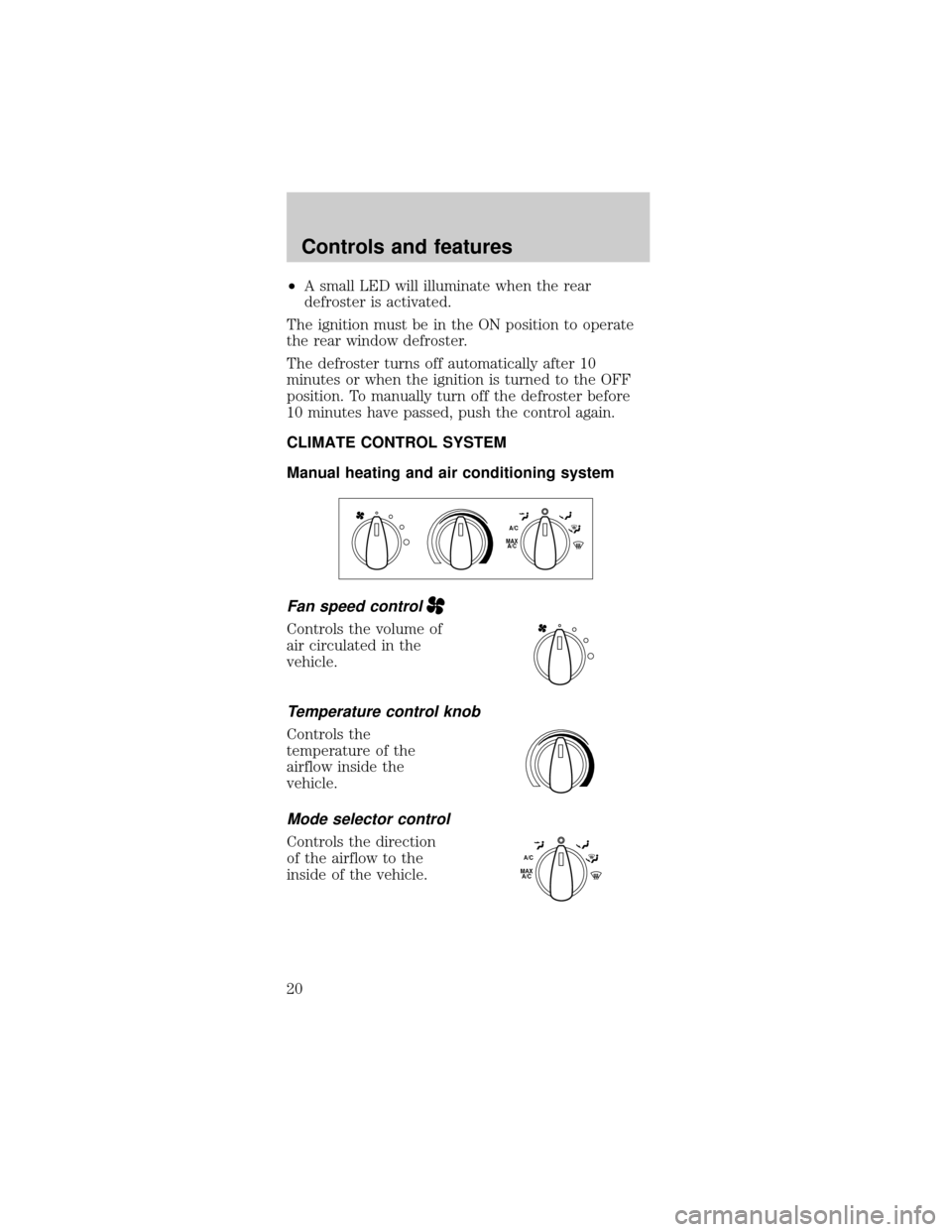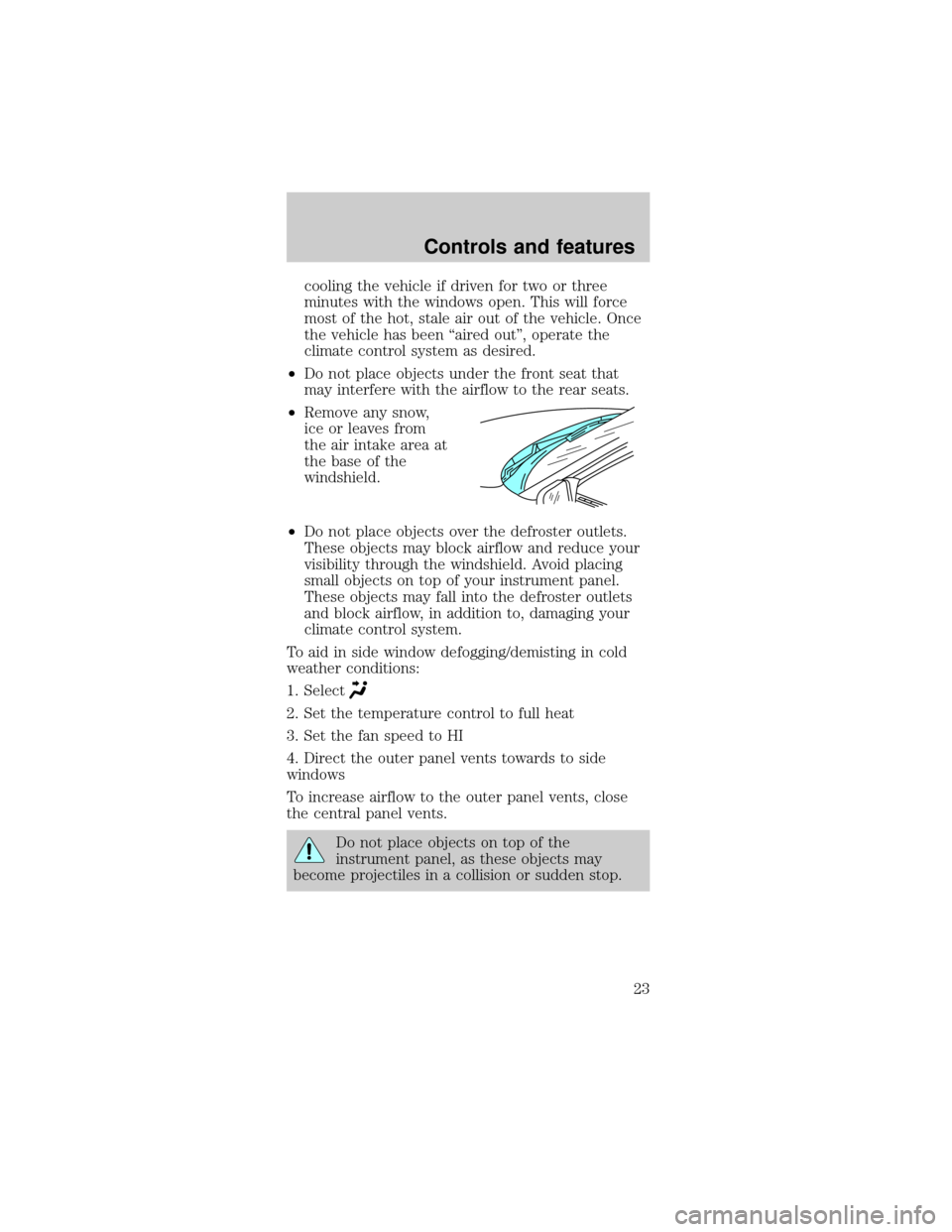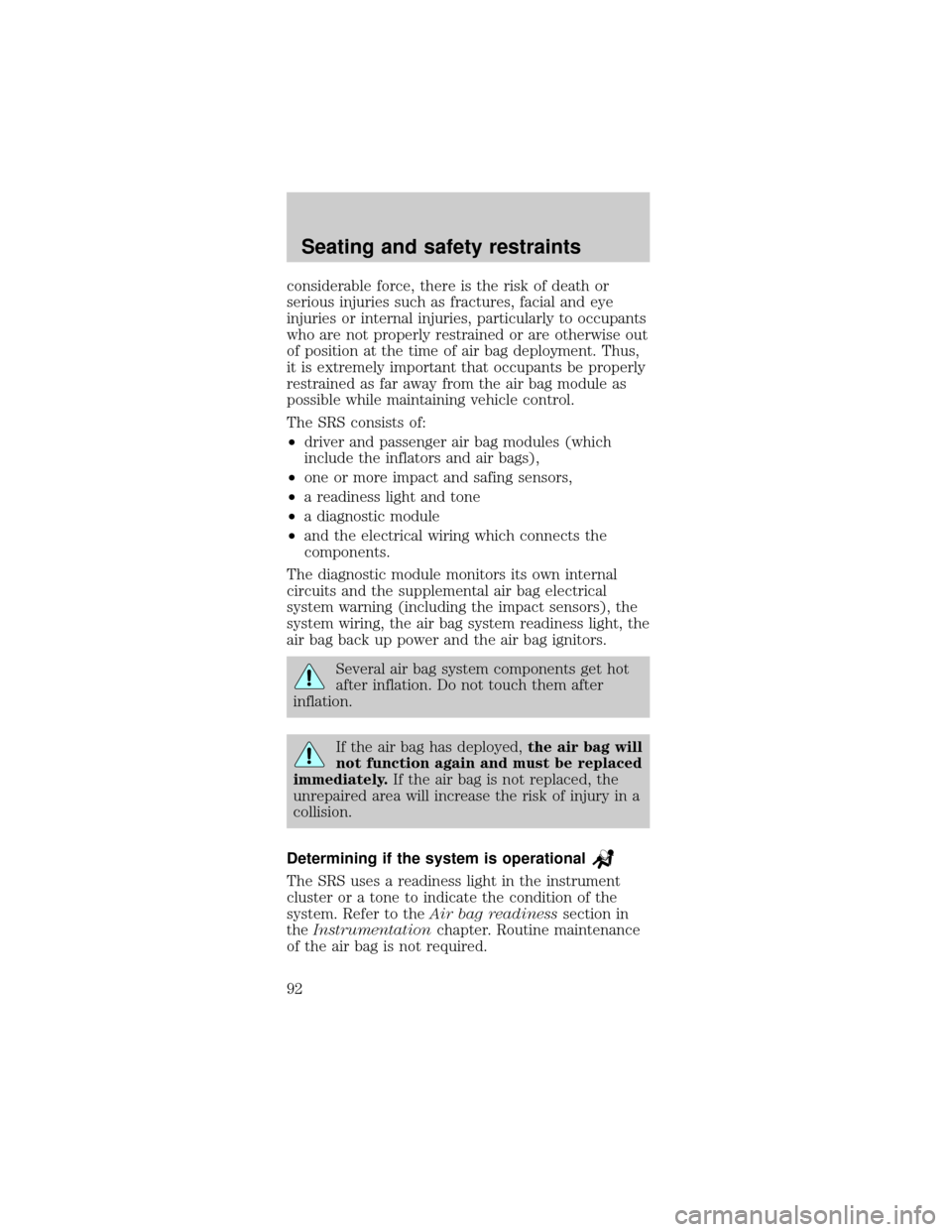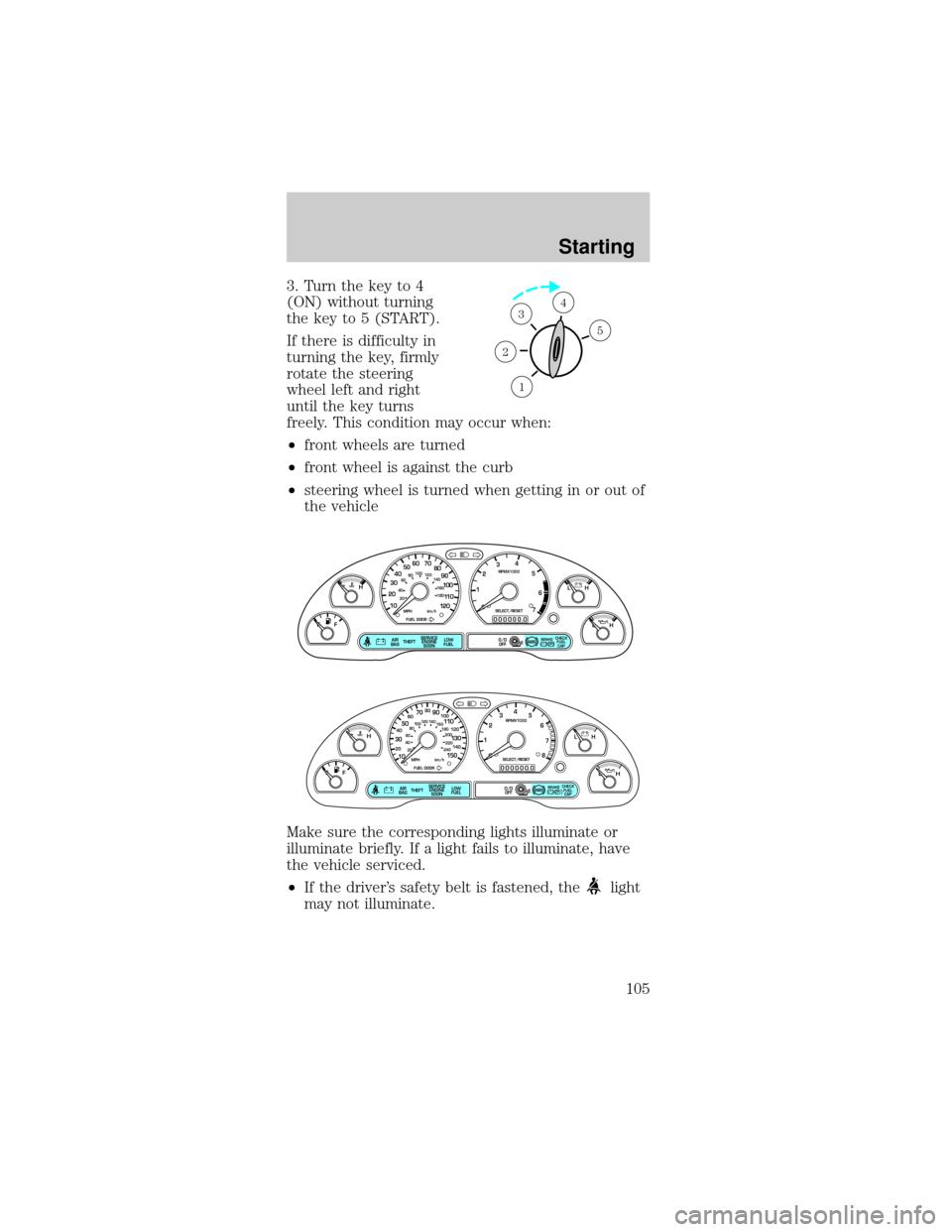2001 FORD MUSTANG air condition
[x] Cancel search: air conditionPage 20 of 240

²A small LED will illuminate when the rear
defroster is activated.
The ignition must be in the ON position to operate
the rear window defroster.
The defroster turns off automatically after 10
minutes or when the ignition is turned to the OFF
position. To manually turn off the defroster before
10 minutes have passed, push the control again.
CLIMATE CONTROL SYSTEM
Manual heating and air conditioning system
Fan speed control
Controls the volume of
air circulated in the
vehicle.
Temperature control knob
Controls the
temperature of the
airflow inside the
vehicle.
Mode selector control
Controls the direction
of the airflow to the
inside of the vehicle.
MAX
A/CA/C
MAX
A/CA/C
Controls and features
20
Page 21 of 240

The air conditioning compressor can operate in all
modes except
and. However, the air
conditioning will only function if the outside
temperature is about 6ÉC (43ÉF) or higher.
Since the air conditioner removes considerable
moisture from the air during operation, it is normal
if clear water drips on the ground under the air
conditioner drain while the system is working and
even after you have stopped the vehicle.
²MAX A/C-Uses recirculated air to cool the vehicle.
MAX A/C is noisier than NORM A/C but more
economical and will cool the inside of the vehicle
faster. Airflow will be from the instrument panel
registers. This mode can also be used to reduce
undesirable odors from entering the vehicle.
²A/C-Uses outside air to cool the vehicle. It is
quieter than MAX A/C but not as economical.
Airflow will be from the instrument panel
registers.
²
(Panel)-Distributes outside air through the
instrument panel registers. However, the air will
not be cooled below the outside temperature
because the air conditioning does not operate in
this mode.
²OFF-Outside air is shut out and the fan will not
operate. For short periods of time only, use this
mode to prevent undesirable odors from entering
the vehicle.
²
(Floor)-Allows for maximum heating by
distributing outside air through the floor ducts.
However, the air will not be cooled below the
outside temperature because the air conditioning
does not operate in this mode.
²
(Floor and defrost)-Distributes outside air
through the windshield defroster ducts and the
floor ducts. Heating and air conditioning
capabilities are provided in this mode. For added
customer comfort, when the temperature control
knob is anywhere in between the full hot and full
Controls and features
21
Page 22 of 240

cold positions, the air distributed through the
floor ducts will be slightly warmer than the air
sent to the windshield defroster ducts. If the
temperature is about 6ÉC (43ÉF) or higher, the air
conditioner will automatically dehumidify the air
to reduce fogging.
²
-Distributes outside air through the
windshield defroster ducts. It can be used to clear
ice or fog from the windshield. If the temperature
is about 6ÉC (43ÉF) or higher, the air conditioner
will automatically dehumidify the air to reduce
fogging.
Operating tips
²In humid weather, place the climate control
system in
before driving. This will reduce
fogging on your windshield. Once the windshield
has been cleared, operate the climate control
system as desired.
²To reduce humidity buildup inside the vehicle in
cold weather conditions, do not drive with the
climate control system in the OFF or MAX A/C
position.
²To reduce humidity buildup inside the vehicle in
warm weather conditions, do not drive with the
climate control system in the OFF position.
²Under normal weather conditions, your vehicle's
climate control system should be left in any
position other than MAX A/C or OFF when the
vehicle is parked. This allows the vehicle to
ªbreatheº through the outside air inlet duct.
²Under snowy or dirty weather conditions, your
vehicle's climate control system should be left in
the OFF position when the vehicle is parked. This
allows the climate control system to be free from
contamination of outside pollutants.
²If your vehicle has been parked with the windows
closed during warm weather conditions, the air
conditioner will perform more efficiently in
Controls and features
22
Page 23 of 240

cooling the vehicle if driven for two or three
minutes with the windows open. This will force
most of the hot, stale air out of the vehicle. Once
the vehicle has been ªaired outº, operate the
climate control system as desired.
²Do not place objects under the front seat that
may interfere with the airflow to the rear seats.
²Remove any snow,
ice or leaves from
the air intake area at
the base of the
windshield.
²Do not place objects over the defroster outlets.
These objects may block airflow and reduce your
visibility through the windshield. Avoid placing
small objects on top of your instrument panel.
These objects may fall into the defroster outlets
and block airflow, in addition to, damaging your
climate control system.
To aid in side window defogging/demisting in cold
weather conditions:
1. Select
2. Set the temperature control to full heat
3. Set the fan speed to HI
4. Direct the outer panel vents towards to side
windows
To increase airflow to the outer panel vents, close
the central panel vents.
Do not place objects on top of the
instrument panel, as these objects may
become projectiles in a collision or sudden stop.
Controls and features
23
Page 92 of 240

considerable force, there is the risk of death or
serious injuries such as fractures, facial and eye
injuries or internal injuries, particularly to occupants
who are not properly restrained or are otherwise out
of position at the time of air bag deployment. Thus,
it is extremely important that occupants be properly
restrained as far away from the air bag module as
possible while maintaining vehicle control.
The SRS consists of:
²driver and passenger air bag modules (which
include the inflators and air bags),
²one or more impact and safing sensors,
²a readiness light and tone
²a diagnostic module
²and the electrical wiring which connects the
components.
The diagnostic module monitors its own internal
circuits and the supplemental air bag electrical
system warning (including the impact sensors), the
system wiring, the air bag system readiness light, the
air bag back up power and the air bag ignitors.
Several air bag system components get hot
after inflation. Do not touch them after
inflation.
If the air bag has deployed,the air bag will
not function again and must be replaced
immediately.If the air bag is not replaced, the
unrepaired area will increase the risk of injury in a
collision.
Determining if the system is operational
The SRS uses a readiness light in the instrument
cluster or a tone to indicate the condition of the
system. Refer to theAir bag readinesssection in
theInstrumentationchapter. Routine maintenance
of the air bag is not required.
Seating and safety restraints
92
Page 105 of 240

3. Turn the key to 4
(ON) without turning
the key to 5 (START).
If there is difficulty in
turning the key, firmly
rotate the steering
wheel left and right
until the key turns
freely. This condition may occur when:
²front wheels are turned
²front wheel is against the curb
²steering wheel is turned when getting in or out of
the vehicle
Make sure the corresponding lights illuminate or
illuminate briefly. If a light fails to illuminate, have
the vehicle serviced.
²If the driver's safety belt is fastened, the
light
may not illuminate.
1
2
34
5
P! BRAKE
L
0
00000 00
C
E
FH
LH
10 203020 406080100
120
140
160
180
405060 70
80
90
100
11 0
1204
5
6
7 3
2
1
H
THEFT
RPMX1000
FUEL DOORSELECT/RESET
LOW
FUELO/D
OFF AIR
BAGSERVICE
ENGINE
SOON
MPH km/h
ABS
.
CHECK
FUEL
CAP
P! BRAKE
L
0
00000 00
C
E
FH
LH
102040608020 40608010 012 0 14 0
160
180
200
220
240
100
120
140
305070 90
110
13 0
1504
5
6
7
8 3
2
1
H
THEFT
RPMX1000
FUEL DOORSELECT/RESET
LOW
FUELO/D
OFF AIR
BAGSERVICE
ENGINE
SOON
MPH km/h
ABS
.
CHECK
FUEL
CAP
Starting
105
Page 107 of 240

To prevent electrical shock, do not use your
heater with ungrounded electrical systems
or two-pronged (cheater) adapters.
Guarding against exhaust fumes
Although odorless and colorless, carbon monoxide is
present in exhaust fumes. Take precautions to avoid
its dangerous effects.
If you ever smell exhaust fumes of any kind
inside your vehicle, have your dealer inspect
and fix your vehicle immediately. Do not drive if
you smell exhaust fumes. These fumes are harmful
and could kill you.
Have the exhaust and body ventilation systems
checked whenever:
²the vehicle is raised for service.
²the sound of the exhaust system changes.
²the vehicle has been damaged in a collision.
WARNING:Engine exhaust, some of its
constituents, and certain vehicle components
contain or emit chemicals known to the State of
California to cause cancer and birth defects or
other reproductive harm. In addition, certain fluids
contained in vehicles and certain products of
component wear contain or emit chemicals known
to the State of California to cause cancer and birth
defects or other reproductive harm.
Important ventilating information
If the engine is idling while the vehicle is stopped in
an open area for long periods of time, open the
windows at least 2.5 cm (one inch).
Adjust the heating or air conditioning (if equipped)
to bring in fresh air.
Improve vehicle ventilation by keeping all air inlet
vents clear of snow, leaves and other debris.
Starting
107
Page 110 of 240

stopping distance. Always leave enough room
between your vehicle and the vehicle in front of
you to stop.
²We recommend that you familiarize yourself with
this braking technique. However, avoid taking any
unnecessary risks.
Hydraulic brake booster system (Hydroboost)
The Hydroboost system receives fluid pressure from
the power steering pump to provide power assist
during braking.
The sound of the pump operating may be heard by
the driver, but this is a normal characteristic of the
system.
For Hydroboost-equipped vehicles operating under
normal conditions, the noise of the fluid flowing
through the booster may be heard whenever the
brake is applied. This condition is normal. Vehicle
service is not required.
If braking performance or pedal response becomes
very poor, even when the pedal is strongly depressed,
it may indicate the presence of air in the hydraulic
system or leakage of fluid. Stop the vehicle safely as
soon as possible and seek service immediately.
Parking brake
Apply the parking
brake whenever the
vehicle is parked. To
set the parking brake,
apply the brake pedal
and pull the parking
brake handle up as far
as possible.
The BRAKE warning
lamp in the instrument
cluster illuminates and
remains illuminated
(when the ignition is turned ON) until the parking
brake is released.
P!
BRAKE
Driving
110